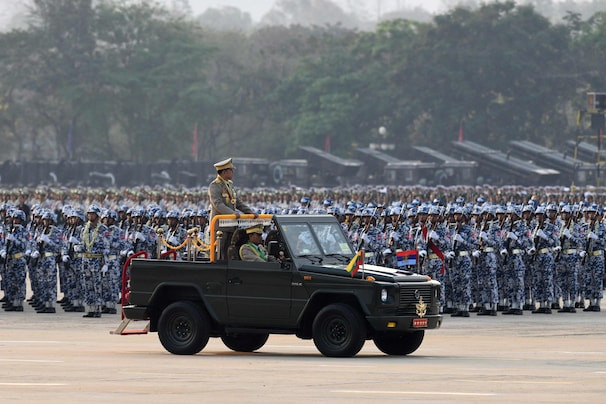YANGON, Myanmar — An airstrike in the Sagaing region of northwestern Myanmar killed dozens of people early Tuesday, according to eyewitnesses and leaders of insurgent groups that have been fighting the country’s military junta.
Entire buildings were reported leveled in the attack on Kanbalu Township, about 130 miles northwest of Mandalay, in what might have been one of the deadliest such strikes since Myanmar’s military seized power in a coup two years ago.
The military took responsibility for the airstrike Tuesday evening but denied that it killed civilians, saying instead that the attack targeted “terrorists.”
“Yes, we launched the airstrike,” military spokesman Zaw Min Tun told a state-backed television channel.
Opponents of the military had gathered with local residents in Kanbalu’s Pa Zi Gyi village Tuesday morning to mark the opening of a new office of an administrative unit of the People’s Defense Force (PDF), a self-proclaimed rebel army formed in the wake of the coup, according to eyewitnesses. Midway through the ceremony, a little before 8 a.m., a fighter jet was seen overhead, followed by an Mi-35 helicopter, said a leader of the Kanbalu PDF’s 4th Battalion, who spoke on the condition of anonymity for security reasons. The aircraft dropped bombs and opened fire on the crowd, causing chaos, witnesses said.
Casualties are still being counted, the PDF leader said, but the unit’s early estimates are that as many as 70 people were killed. Dozens more, including children, were rushed to hospitals. Videos and photos from Kanbalu provided to The Washington Post show mangled bodies and body parts in the rubble, many covered in dust and ash. “We can’t even collect the dead,” said the PDF leader. “It’s all still burning.”
Kyaw Wunna, a rescuer who helped the injured at Pa Zi Gyi, said the number of fatalities could be as high as 100. Several injured people died as rescuers tried to take them to a hospital, he said.
The airstrike could constitute a war crime, said the National Unity Government, a parallel administration that was formed in the wake of the coup. Aung Myo Min, the NUG minister for human rights, said many of those who were killed are civilian women and children. He described the attack as part of the military’s “terror campaign to make people fear their retaliation.”
Zaw Min Tun, the military spokesman, acknowledged that the airstrike killed people but said they were “PDF terrorists” claiming to be civilians. “The artillery hit the buildings where the PDFs stored their weapons and ammunition,” he said. “That’s why it exploded and people died.”
Myanmar’s military has stepped up its aerial offensive against resistance fighters in recent months, using its arsenal of Russian-supplied aircraft to inflict heavy casualties. In September, two military helicopters attacked a school, killing 11 children, according to the United Nations. In October, a jet opened fire on an outdoor concert, leaving as many as 80 people dead.
Many of these attacks have targeted the sprawling Sagaing region, a resistance stronghold that has seen some of the fiercest fighting since the coup. More than 600,000 people in Sagaing have been displaced by the conflict, according to the U.N. Office for the Coordination of Humanitarian Affairs. But the junta has increasingly blocked aid groups’ access to the region, including in the wake of deadly attacks.
Amnesty International on Tuesday reiterated its call for governments to ban the supply of aviation fuel to the Myanmar military. “Unlawful air attacks killing and injuring civilians and destroying homes are a trademark of the Myanmar military,” said Montse Ferrer, an Amnesty researcher. “Myanmar’s civilians bear the brunt of these sickening tactics.”











